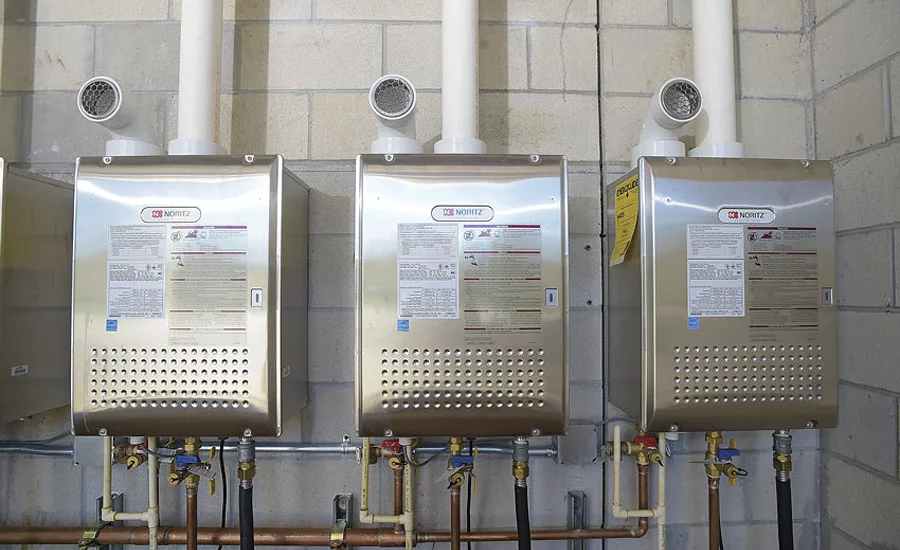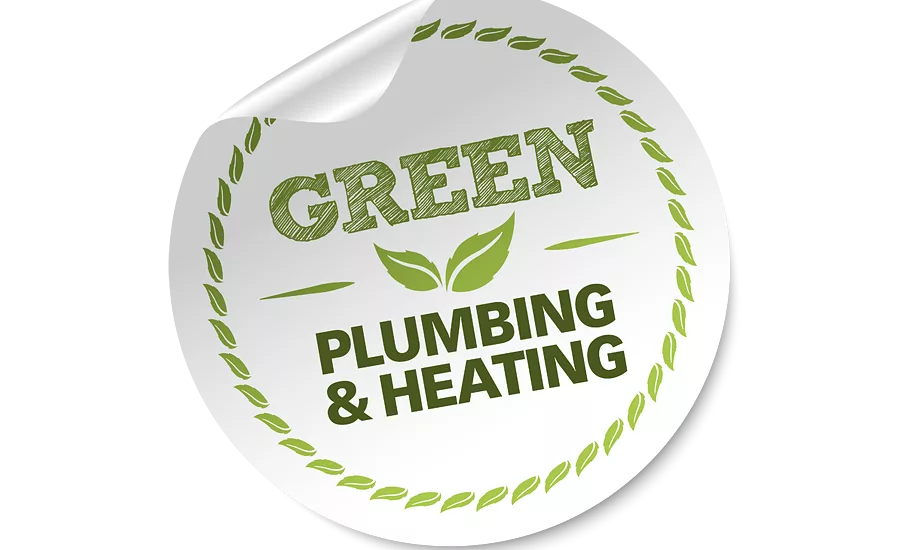Restaurants benefit from installing tankless water heaters
The worry over hot water.

An engineered rack system connects as many as six tankless water-heating units, allowing for total Btu capacity to be split among multiple water heaters. Photo credit: Bruce Damonte

Combining multiple tankless units brings the benefit of redundancy for restaurants. If one fails, it is still possible to stay open until a replacement arrives. Photo credit: Associated Press

This article is part of PM’s annual Green Plumbing & Heating special section.
A number of things can go wrong in a restaurant that can upset customers. Most are inconveniences that probably will not pose an existential threat to the establishment. What will shut it down completely, however, is a broken water heater. In a poll of restaurant facility managers asking, “What is the single biggest item at a restaurant that causes you the most concern and can shut you down?” an overwhelming 95% responded with “water heater.”
Restaurants need hot water in massive amounts to meet all of their cooking, washing, and sanitation needs. According to the National Restaurant Association, quick-service restaurants consume 500 to 1,500 gallons of water daily while full-service restaurants consume as much as 5,000 gallons — most of which is heated. Arguably, a restaurant needs hot water more than any other modern establishment. Indeed, by local ordinance, it cannot exist otherwise.
The threat of a failing water heater is not an empty one. The average lifespan of a commercial unit is between five and seven years due to the routine heavy use and high water temperatures, according to National Hot Water, an on-demand, nationwide water heating service. Furthermore, if the facility manager is one who generally avoids or delays preventive maintenance for financial reasons, the risk of failure increases exponentially. U.S. Department of Energy statistics state that nearly 60% of commercial water heater replacements result from emergency breakdown or poor performance, meaning that most managers run their units right up to doomsday.
Even if the user practices preventive maintenance, he or she still faces the risk of running out of hot water during periods of heavy use if the unit is improperly sized. Some contractors try to overcome this problem by installing more than one water heater. In that case, peace of mind comes at the cost of housing two or more space-killing tanks that are always inefficiently running at their maximum Btu capacity.
The tankless option
Tankless water heaters are exactly what their name denotes: A water heater that, instead of heating stored water in a tank, uses a high-powered burner to quickly heat incoming cold water to meet demand.
When a hot water valve is turned on, the sensor in the tankless unit detects the water flow, and the burner inside automatically fires. Water flows through the tankless unit’s secondary heat exchanger, where it is pre-heated by combustion gases as they escape up the flue. The pre-heated water then enters the primary heat exchanger, which completes the process of raising the temperature to the desired level. Once activated, the tankless unit provides a continuous stream of hot water until the outlet is turned off.
Tankless units can vent using installer-friendly PVC piping rather than category III stainless steel because the pre-heating process cools combustion gases enough to be handled by PVC. In warmer climates, the tankless unit can be installed outside, eliminating the need for venting entirely.
A sufficient supply of hot water at the correct temperature for as long as needed is a great option for a restaurant. Why has this technology not become more mainstream?
Traditional tank-type water heaters have dominated the market for so long that many consumers — and restaurant operators — are hesitant to switch. Despite this reality, tankless has been gaining ground. Widely available in North America since the early 2000s, tankless controls a growing share of the total water heating market and continues to outpace the annual growth of traditional tanks, as reported by the Air-Conditioning, Heating & Refrigeration Institute. Especially important is the fact that tankless meets all plumbing code requirements nationwide.
Even as the tankless market grows, however, it must contend with several misconceptions and inferiority myths. Optically, tank-type water heaters are more reassuring with their size — often accompanied by an additional storage tank — than their far-smaller tankless counterparts. It is difficult for many to believe that a medicine-cabinet-sized unit can produce unlimited hot water. Additionally, many balk at the higher upfront costs associated with tankless and opt for technology they are more comfortable with.
With these myths aside, it is time to set the record straight about tankless water heaters, especially in high-demand commercial environments that can ill afford any interruption in service. A restaurant owner or facility manager is looking for three main features when choosing a water heater: immediate access to sufficient supplies of hot water, equipment reliability, and cost-effective operation. Tankless provides all three.
Immediate access
A restaurant’s water heater need not fail completely in order to cause serious problems. If it was improperly sized during installation, the tank may not hold enough hot water to meet demand during those crazy evenings when the restaurant is hosting two graduation parties and a wedding reception. Even when a water heater is properly sized, the risk always exists that an abnormally high demand will overwhelm it, meaning no hot water and no business.
Once a properly sized tankless unit turns on, it will continue providing sufficient amounts of hot water for as long as needed. Furthermore, there is no need to worry about the infamous “cold water sandwich,” because all the water will be heated as it passes through the unit’s heat exchanger.
A hot water recirculation system used in conjunction with an aquastat and timer can maximize energy savings. The timer will ensure instant hot water is available in the piping at peak times, and the aquastat will add even greater efficiency by overriding the timer if the pipe water is sufficiently hot. This eliminates the need for the system to run constantly.
Reliability
Tankless water heaters can handle up to 12 years of heavy commercial use. They do not need to run 24 hours per day to have hot water available. Instead, they run only when needed, meaning less wear and tear on a daily basis.
When tankless water heaters do give out, it is typically because their heat exchangers have failed. Oftentimes, these heat exchangers can simply be replaced, extending the lifespan even further.
Facility managers can combine their tankless units to maximize efficiency. An engineered rack system connects as many as six units with isolation valves, system and pump controllers, surge protectors, and even recirculation pumps and expansion tanks as needed. This allows for total Btu capacity to be split among multiple water heaters that have modulating burners, allowing for the minimum amount of energy to be used to handle a particular demand.
For example, if a single faucet is turned on, only one tankless unit will fire, using the minimum necessary amount of its potential Btu. Tankless units’ ability to match load ensures efficient operation and energy savings.
Cost effectiveness
At the end of the day, cost is likely among the most important considerations when investing in a water heater. Up front, tankless water heaters cost more than tank-types due to their more powerful technology, but the savings gained over time will compensate for these costs, especially in a commercial setting.
In a restaurant, tankless units run frequently during peak business hours and then cease almost completely until the next day. On-demand hot water usually translates into significant monthly energy savings.
A tankless unit’s long life means more time between replacements. That alone may justify the extra upfront cost to install a tankless water heater.
For restaurant owners and facility managers, tankless water heaters can be a business-saver, providing proper amounts of hot water to satisfy daily demand. When hooked together in a rack system, these units efficiently deliver the minimum amount of energy needed to meet the particular load, saving even more energy.
As with any appliance, preventive maintenance is strongly recommended with a tankless water heater, especially in a commercial setting. It is important to flush and descale tankless water heaters on a regular basis, as frequently as every six months depending on usage and water hardness. The high water temperatures required in a restaurant may result in quicker scale buildup than would otherwise be the case. Tankless units are resistant to scale buildup, as an absence of stored water helps prevent sediments from settling.
It is advised to filter incoming water in order to maximize quality and reduce the toll on the tankless system. This recommendation is not unique to tankless, however.
One additional cost factor to consider is the gas-line requirement for tankless water heaters, which may be larger because of the high water temperatures needed. Ensure that the proper amount of gas is supplied by increasing the pipe diameter or water meter size, if necessary. For those concerned with the financial burden this may create, tankless units’ efficient operation and long life should yield savings that will more than compensate for the higher upfront purchase and installation costs.
Meanwhile, the peace of mind gained from knowing enough hot water will always be there when needed, even when the facility is running at peak demand, is priceless.
This article was originally titled “The worry over hot water” in the November 2016 print edition of Plumbing & Mechanical.
Looking for a reprint of this article?
From high-res PDFs to custom plaques, order your copy today!






